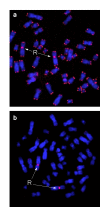Sex-related differences in length and erosion dynamics of human telomeres favor females
- PMID: 20195387
- PMCID: PMC2830083
- DOI: 10.18632/aging.100068
Sex-related differences in length and erosion dynamics of human telomeres favor females
Abstract
Telomeres are repetitive DNA sequences at chromosomal ends contributing to genomic integrity. In somatic cells, telomeres are shortened during DNA reduplication. Thus, telomere erosion has been regarded as a biological clock. Applying the telomere/centromere (T/C)-FISH technique to human peripheral blood lymphocytes, we showed that pangenomically, telomere shortening is linear in centenarians and that this attrition is delayed in females. Statistics reveal a greater skewness in telomere length distribution in females. As the morphological correlate, we find abnormally long telomeres distributed at random. This "erratic extensive elongation" (EEE) of telomeres is a hitherto unrecognized phenomenon in non-neoplastic cells, and females are more successful in this respect. As evidenced by endoreduplication, EEE is transmitted to the cells' progeny. The mechanism involved is likely to be the alternative pathway of telomere elongation (ALT), counteracting erosion and already known to operate in neoplastic cells.
Keywords: T/C-FISH; alternative pathway; telomere length.
Conflict of interest statement
The authors in this manuscript have no conflict of interests to declare.
Figures



Similar articles
-
Accelerated telomere shortening in the human inactive X chromosome.Am J Hum Genet. 1999 Dec;65(6):1617-22. doi: 10.1086/302665. Am J Hum Genet. 1999. PMID: 10577915 Free PMC article.
-
Long-Term Effects of Radiation Exposure and Metabolic Status on Telomere Length of Peripheral Blood T Cells in Atomic Bomb Survivors.Radiat Res. 2016 Oct;186(4):367-376. doi: 10.1667/RR14389.1. Epub 2016 Sep 14. Radiat Res. 2016. PMID: 27626826
-
Quantitative fluorescence in situ hybridization for investigation of telomere length dynamics in the pituitary gland using samples from 128 autopsied patients.Tissue Cell. 2018 Aug;53:1-7. doi: 10.1016/j.tice.2018.05.008. Epub 2018 May 19. Tissue Cell. 2018. PMID: 30060819
-
"Is obesity linked to aging?": adipose tissue and the role of telomeres.Ageing Res Rev. 2012 Apr;11(2):220-9. doi: 10.1016/j.arr.2011.12.003. Epub 2011 Dec 13. Ageing Res Rev. 2012. PMID: 22186032 Review.
-
Telomeres and Female Reproductive Aging.Semin Reprod Med. 2015 Nov;33(6):389-95. doi: 10.1055/s-0035-1567823. Epub 2015 Dec 2. Semin Reprod Med. 2015. PMID: 26629734 Review.
Cited by
-
Reproductive history and blood cell telomere length.Aging (Albany NY). 2018 Sep 19;10(9):2383-2393. doi: 10.18632/aging.101558. Aging (Albany NY). 2018. PMID: 30243019 Free PMC article.
-
Leukocyte telomere length in HIV-infected and HIV-exposed uninfected children: shorter telomeres with uncontrolled HIV viremia.PLoS One. 2012;7(7):e39266. doi: 10.1371/journal.pone.0039266. Epub 2012 Jul 16. PLoS One. 2012. PMID: 22815702 Free PMC article. Clinical Trial.
-
Relation between leukocyte telomere length and incident coronary heart disease events (from the 1995 Canadian Nova Scotia Health Survey).Am J Cardiol. 2013 Apr 1;111(7):962-7. doi: 10.1016/j.amjcard.2012.12.017. Epub 2013 Jan 29. Am J Cardiol. 2013. PMID: 23375186 Free PMC article.
-
Short Telomere Length is Associated with Aging, Central Obesity, Poor Sleep and Hypertension in Lebanese Individuals.Aging Dis. 2018 Feb 1;9(1):77-89. doi: 10.14336/AD.2017.0310. eCollection 2018 Feb. Aging Dis. 2018. PMID: 29392083 Free PMC article.
-
Posttraumatic stress disorder and not depression is associated with shorter leukocyte telomere length: findings from 3,000 participants in the population-based KORA F4 study.PLoS One. 2013 Jul 3;8(7):e64762. doi: 10.1371/journal.pone.0064762. Print 2013. PLoS One. 2013. PMID: 23843935 Free PMC article.
References
-
- Anderson RN, Smith BL. Deaths: leading causes for 2001. Natl Vital Stat Rep. 2003;52:1–85. - PubMed
-
- Hayflick L. The limited in vitro lifetime of human diploid cell strains. Exp Cell Res. 1965;37:614–636. - PubMed
-
- Harley CB, Futcher AB, Greider CW. Telomeres shorten during ageing of human fibroblasts. Nature. 1990;345:458–460. - PubMed
MeSH terms
LinkOut - more resources
Full Text Sources
Medical
Research Materials
